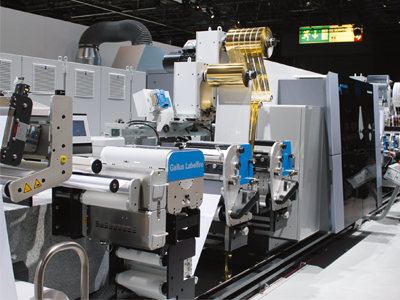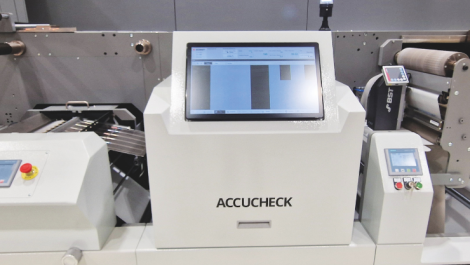Gallus Labelfire 340 press running at drupa
The term ‘hybrid’ has been bandied about a lot in the last year and it covers a wide range of options when it comes to merging analogue and digital production methods. While the phrase may be overused, please bear with me as it is worth taking a look at some of the many varieties of the species, says Neel Madsen
It was the word de jour at last year’s Labelexpo, but while it could be argued that the market is not big enough to support that many hybrid, or combination, presses, some jobs lend themselves perfectly to this particular print method. This can be achieved in a several ways – by adding a smaller inkjet module onto an existing press or converting line framework, or by incorporating a full digital print engine into an analogue platform thereby creating a new configuration, and in effect, a new printing press. Examples of the latter have been brought to market through cooperation between established press manufacturers from the conventional and digital worlds.
In retrospect
An inkjet module is a great low cost option that offers the capability to print digital as and when needed. This either comes with the press or it can be retrofitted to an established press line.
‘We saw an opportunity to significantly reduce the indecision and barrier of entry into digital by introducing our retrofit solution to the market,’ said Taylor Buckthorpe, director of market development, Colordyne Technologies. ‘The retrofit creates a level of comfort for converters. They are able to introduce digital printing onto an asset they are already familiar with,’ he continued. Colordyne’s water-based inkjet module prints at speeds up to 152 m/min at resolutions up to 1600 x 1375 dpi. The memjet-powered technology provides a smooth appearance similar to flexo.
‘Being able to replicate flexo is critical for a converter, because as digital business grows, they need to be able to transition this work back to flexo without having to resell the label to the brand owner or end user,’ explained Mr Buckthorpe. ‘Should a customer require one million labels, but also have a need for a 5000 label job, each order can be completed on the same press.’
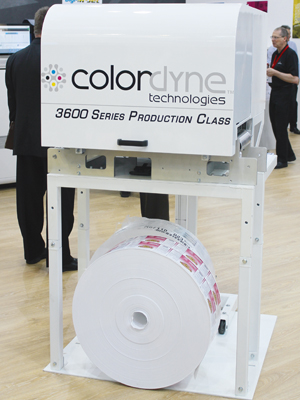
Colordynes’s retrofit module
Colordyne’s 3600 Series Retrofit can be integrated into most flexo presses. ‘Our approach was simple, and we didn’t want to over-complicate digital. We designed the product to simply bolt on to existing frames or rails,’ said Mr Buckthorpe. ‘Our simplistic approach enables converters to easily duplicate existing finishing processes and the print to die registration is no issue.’ He concluded, ‘The combination of digital and flexo is what our customers love most. They can add an additional one or two spot colours with ease to the digitally printed image and it doesn’t look like two different technologies were used to produce the label.’
Prototype & Production Systems, Inc (PPSI) has the DICEweb colour UV inkjet engine, also offered as an add-on to any inline flexo press. The module is available in up to six colours and runs at speeds up to 110 m/min. It is currently available in widths up to 508 mm, but wider versions are available by special order.
The precision-machined arched roller design keeps the web flat and stable under the printheads, and the use of UV-curable inks overcomes the problems of water-based inks that are not suitable for most common label stocks. Reliability is critical in single pass inkjet printers, and the DICEweb achieves this through its use of recirculating ink supplies and flow through printheads, and by employing built-in automatic head maintenance and a capping station using a vacuum knife to clean the heads. The system’s piezo-electric printheads are repairable, which reduces maintenance costs.
More modules
Xaar launched the Print Bar System last year when it was first seen on FFEI’s Graphium press. This incorporates Xaar’s 1002 printheads adding single-pass inkjet capability to both web and sheetfed presses. Available in a range of print widths from 70 mm up to 560 mm, and single or dual configurations with print speeds up to 75 m/min as standard, the system is designed to be integrated into a wide range of press configurations; at any point on the press. It can be retrofitted to existing analogue presses, designed into new builds or used as a standalone unit.
The system can handle a wide range of inks and fluids, including spot colours (K or CMY), protective lacquers, high-build spot varnish, heavily pigmented high opacity whites, cold foil adhesives and metallics, which means users can add special effects and variable data digitally. It is presented as a ‘ready to use’ system featuring a choice of Xaar 1002 printheads (GS6, GS12 or GS40 depending on the application), an ink supply system, and full print management and workflow capabilities to ensure total control of the print process.
Industrial Inkjet (IIJ) has recently worked with AB Graphic to deliver an integrated system to Traderplus in South Africa. The company produces more than 750 million swing tickets a year and counts global retail outlets such as Walmart amongst its customers.
Following the initial success of IIJ installations at both its Durban headquarters and in Suzhou, China, Traderplus is adding to this portfolio with two more lines, with inkjet printing provided by IIJ. These are due for installation in July of this year. The £2 million total investment includes both MonoPrint and ColourPrint engines. The IIJ systems are fitted onto bases supplied by ABG.
Dudley Cherry, CEO of Traderplus, said, ‘IIJ’s highly flexible and customised solution is providing us with full variable data printing in both mono and CMYK (colour). We wanted a big step up and the solution from IIJ is the most suitable by far from an inkjet perspective and is putting daylight between us and our competitors.’
Another user of IIJ’s modules is Focus Label Machinery, which integrates the ColourPrint 142 iS print engine into its d-Flex press. This offers inline converting that includes a flexo printing or coating unit and full rotary die-cutting as well as cold foiling and slitting to produce finished labels. This flexible option can be used independently as a standalone production machine or as a converting line for pre-printed rolls of labels.
In finishing
Label converting machines are often modular in nature and thus adding digital as part of the mix is a very flexible way of gaining digital capability without investing in a new press. Danish manufacturer Werosys has just launched a digital print module for its finishing line to offer integrated digital printing. The module incorporates the same memjet technology found in the TrojanTwo label press from Trojanlabel, and includes nip stations and buffer capacity to allow the print engine to perform its operations without affecting the other operations on the production line. Furthermore it fully integrates data communication between the print engine and the converting line HMI/PLC.
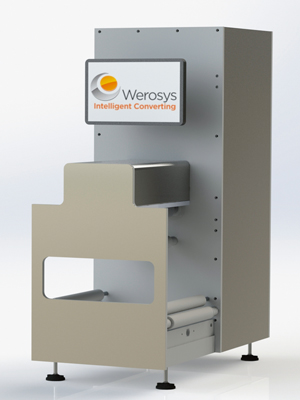
New digital module from Werosys
Søren Pedersen, CTO, explained, ‘We see that the lifetime of a digital print engine is relatively short, before it is replaced by new and improved technology. This means discarding the full digital press every time a new and better digital print technology emerges – our philosophy is to just replace the print engine/print module, thereby safeguarding the investment.’
He continued, ‘We will be launching the digital print module with other print engines in the future. This will also include DOD UV-based systems with higher speeds. The Werosys Compact runs at 65 m/min in semi-rotary mode and 200 m/min in full-rotary mode, so we have a platform that will also handle future speed demands. Should demands be even higher, we have the Werosys Concept line which runs at up 500 m/min.’
Danish view
Screen has cooperated with Nilpeter which leverages its UV inkjet technology printing at speeds up to 50 m/min in CMYK + white, at 600 x 600 resolution using Kyocera printheads. It is not the first combination, or hybrid press, that the Danish press manufacturer has brought to market, and it is using its experience to offer the new Panorama product line to its customers. This consists of two main products: the DP-3 standalone digital press and the combined digital press and inline converting
solution.
‘Nilpeter has chosen the finest UV inkjet platform on the market as our digital printing unit, we have enhanced it, added inline printing and converting, and thereby created the Panorama,’ explained digital product manager Gernot Schneider. ‘Our priorities are top printing quality, printing speed and reliability in terms of uptime.’
The digital DP-3 unit may be combined with the company’s printing and finishing units. ‘We can create an optimised and integrated production solution for any task our customer requires’, said Mr Schneider. ‘Equally important, all configurations are totally modular and can be installed, modified and expanded at any point, even at a later stage if the customer needs a different workflow.’
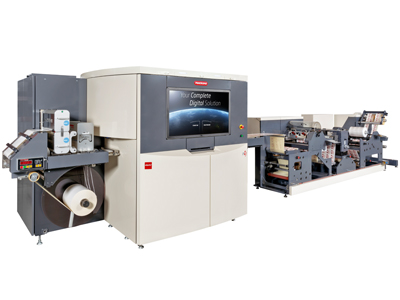
Nilpeter’s Panorama line
Screen’s Equios workflow is included with the DP-3 unit to provide features such as high speed processing using the latest RIP core, text choke, colour matching, colour profile editor, automated step/repeat and smooth hybrid screens.
While Nilpeter believes that using UV-curable ink is the best solution for most label applications, it also believes that there is no universal digital printing technology, and converting processes may require a number of different technologies. ‘There is no winning technology that covers all applications,’ said Jakob Landberg, sales and marketing director. ‘This factor reflects the complexity of the label and packaging printing markets. Nilpeter has always been an advocate of combination printing and has spearheaded technologies that bring together all the different processes for the optimum result. Now, with Panorama, we can deliver highly reliable and productive digital printing and finishing applications, using automation systems, with results that meet brand owners’ expectations.’
A digital platform
With its Digital Series press platform, Mark Andy offers a line of fully integrated technology for single pass inline converting using UV inkjet combined with finishing options. The 330 mm wide press, which prints at speeds up to 76 m/min, can be configured in four colour process plus white with any inline converting process, decorating or finishing operation that would be installed on a traditional flexo press. The Digital Series shares a common platform with the Performance Series technology, which enables it to take advantage of the quick change designs of the Performance Series flexo print station and QCDC (Quick Change Die Cut) die station, for fast changeovers. The front end utilises ProWORX powered by Esko and will integrate into any current workflow structure. Consumables are supplied using a pay-as-you-use model.

The Mark Andy Digital Series
The company stresses that converters can design the press to meet their specific needs, and that custom configurations can be modified as business needs evolve, making the technology future-proof. This in turn provides a lower capital path to stay on top of the latest technology as only a portion of the press needs to be updated as new advances are made.
Gallus showed its Labelfire 340 hybrid press at drupa. Initially named the DCS 340 and launched at Labelexpo 2015, the press was developed as a joint venture between Heidelberg (now owner of Gallus) and Fujifilm, and uses the latter’s Dimatix Samba printheads.
Combining the company’s established ECS 340 press platform with UV DOD inkjet technology, it prints in up to eight colours at a native resolution of 1200 × 1200 dpi with a droplet size of just 2 pl and up to 200 grey scale values. The combination of digital white, CMYK, and orange, violet and green, as well as seven-colour separation, mean the Labelfire can cover a large portion of the Pantone colour space.
The Prinect DFE is supplied by Heidelberg to automate the pre-press workflow and maximise data processing efficiency. Functions such as colour management, automatic spot colour matching, PDF Toolbox and Prinect Prepress Manager make this possible.
Collaborations
The N610i UV inkjet press from Domino Printing Sciences can be delivered as an integration module built into a converting platform from partners AB Graphic International, Converting Equipment International (CEI), Delta ModTech and Gonderflex. The company also works with press manufacturers MPS and Omet, which both build hybrid presses with Domino technology incorporated.
Philip Easton, director digital printing solutions, said, ‘Hybrid printing is ideal for printing longer runs of multiple SKUs where the label shape is the same and it is only the design that changes, such as shampoo labels where six or eight SKUs are essentially one job.’ Peter Lewald, head of sales Europe digital colour systems, added, ‘We find that customers need educating. They are getting more jobs in, but they need to look at the job structure, at the type of jobs and the run length.’
Domino’s collaboration with AB Graphic merges the N610i with the Digicon 3 converting line to form a hybrid machine, which offers inline finishing. This can include flexo stations before and after the digital print module as well as foiling and screen printing, along with die-cutting, slitting and rewinding. To save on the waste associated with the finishing process, a new feature has been developed for this configuration. Web buffers before and after the digital module enable the web to be reversed back through the finishing line (including the flexo stations) for tool changes at job changeover, cutting substrate waste to between 3 and 5 metres.
Mr Easton said that there have been three hybrid installations since Labelexpo last September, and following drupa, it was announced that Autajon (Sinel) is the latest to order a system. The hybrid press will be installed at the Sinel plant in Barcelona, which is part of the international Autajon Group, headquartered in Montelimar, France. This further expands Domino’s UV inkjet capacity at the company, with it now being installed at multiple production sites.
Meeting challenges
Best known for its conventional flexo and offset presses, MPS said it designed its hybrid printing solution with Domino to solve a common challenge facing label printing companies today: how to achieve and maintain a lucrative cost price per square metre in their overall label and packaging print production.
The EF SymJet press combines MPS’s existing EF flexo platform with the Domino N610i inkjet engine. Bert van den Brink, technical director, said, ‘We have created a highly flexible machine that will allow converters to combine flexo and digital printing, or use separately inline, as well as converting in one pass. This solution fills the gap between conventional flexo and digital printing machines.’
While the digital engine has a 333 mm maximum print width, the MPS EF multi-substrate press is wider at 430 mm, giving converters the option to run more labels across when operating in pure flexo mode at higher speed.
Designed for label and flexible packaging printing from thin unsupported film to thick cartonboard, the press offers converting options, including multi-layer label production, die-cutting and lamination. It can be installed either as a fully integrated inline or as a standalone offline digital solution, with the benefits of both flexo with automated pressure settings (including job memory) and digital printing.
The first SymJet was sold during Labelexpo 2015 to Optikett in Germany, an existing MPS customer, which owns seven MPS presses. The company said it will use the press typically for four to six colour short run jobs.
Mr van den Brink said, ‘Some label designs are better suited to print partly in flexo, and the rest digitally. When the job size approaches flexo volumes, the hybrid is a versatile solution to efficiently meet these needs. With the EF SymJet, print jobs can run all flexo (with the Domino serving as a pass-through), all digital (with the MPS EF serving as the material handling and finishing) or a combination of the two working together in hybrid mode.’
Omet’s integration of Domino digital technology was shown at an open house in Lecco in the run up to drupa. The XFlex X6 JetPlus is a hybrid line based on the Italian manufacturer’s existing XFlex X6 platform, which has the inkjet engine integrated between the flexo units and the converting stations. The press prints at 75 m/min, in 600 x 600 dpi, powered by an Esko digital front end.
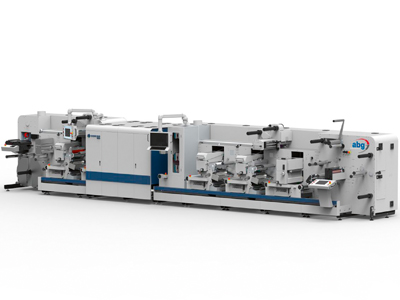
Domino ABG integration line
The butterfly effect
The birth of the Graphium hybrid press was the result of the collaboration between FFEI, Xaar, Edale and Fujifilm specialist ink systems. It has been commercially available since 2013 and comes with a print engine that is capable of printing up to six colours of UV curable inks, including varnish and under/over whites. It can be configured to support substrates up to 430 mm wide and prints on 12 to 450 microns substrates (but can go up to 600 micron when printing in digital mode only). The wider platform offers a productivity up to 1134 sqm/hr, which FFEI said results in a minimum of 23% productivity improvement compared to a 330 mm press running at a similar linear speed of 45 to 50 m/min. Furthermore, Graphium can achieve a full ink and plate change and set up in under 70 seconds.
Tailored Label Products in Wisconsin in the US installed the press earlier this year. ‘We needed to add press capacity to meet rapid growth and increasing demand of our customers, while continuing to advance our digital printing capabilities,’ said Jeff Kerlin, president and CEO. ‘The Graphium allows us tremendous flexibility, combining the advantages of both traditional flexographic and advanced digital print technologies. We can run four colour process plus white digitally without having to make plates, saving time and money, plus add specialty ink like a metallic or specific PMS solid colour using flexo print decks, and run it all inline. Having that flexibility gives us a distinct advantage and allows us to stand out within the industry.’
Customers are using the press to produce a wide variety of applications, such as self-adhesive labels, unsupported films, cartons, blister hanger cards, shrink sleeve, in-mould labels, tickets, wristbands, air filters, peel & reveal labels, retail displays, product, automotive and marine decals.
‘Flexibility with the Graphium is a huge advantage,’ said Mr Kerlin. ‘The key features and benefits of the press were major influencers for us, including the ability to print UV inkjet variable data, the die-cut and the lamination stations, as well as the modular flexo decks before and after the digital print engine, and finally, the inline finishing capabilities.’

Graphium press from FFEI

